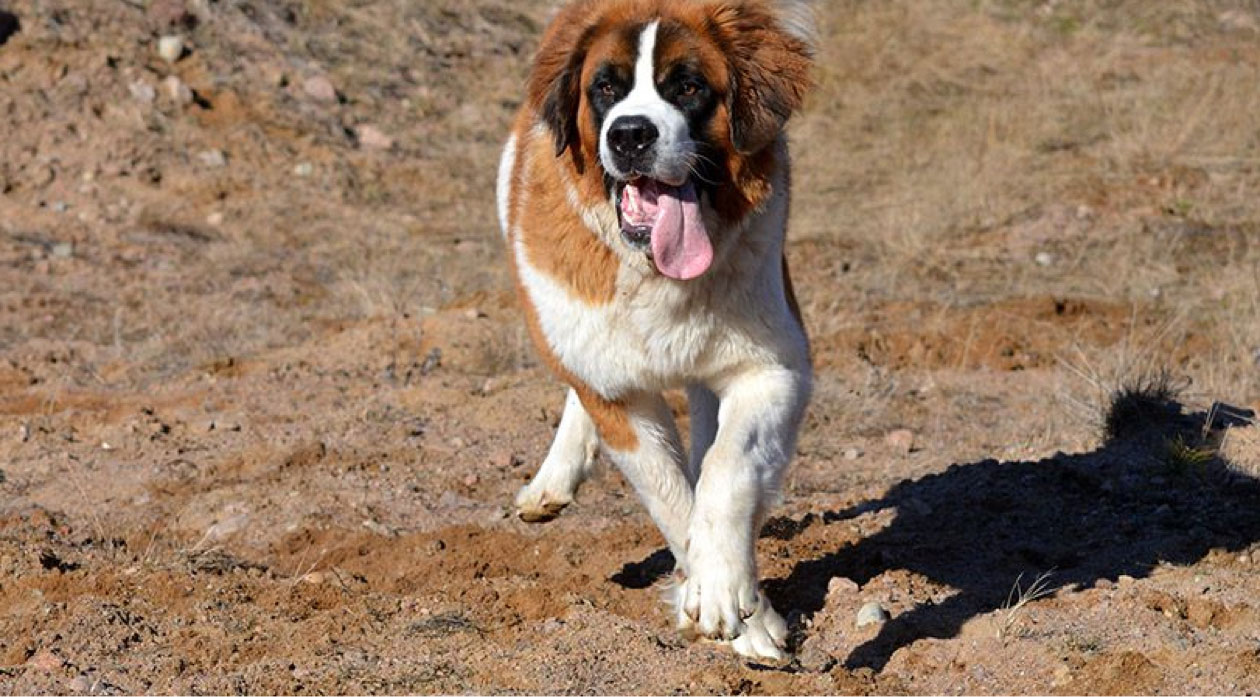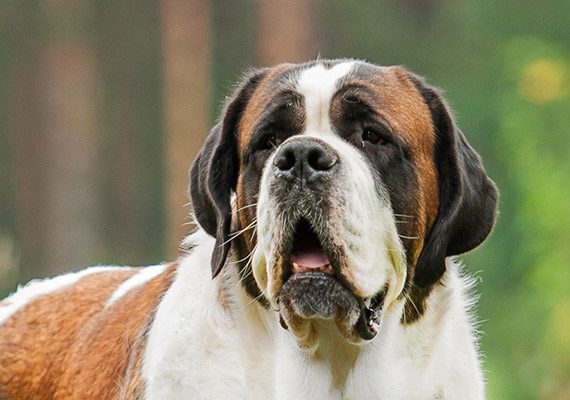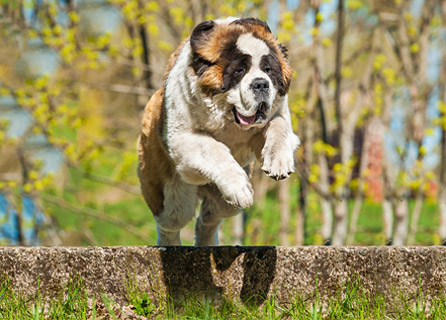
St. Bernard breed guide
The St. Bernard is strong and protective and adores their family. Learn more about this gentle giant with a heart of gold, from their grooming and exercise needs, to the things you can do to keep them happy and healthy.
Breed information and advice
The St. Bernard is part of the working breed group and makes a wonderful family pet, thanks to their loyal and caring nature. They take up a lot of room at home, making them best suited to larger homes with outdoor space where they can stretch out. Here’s more you should know:
- Before getting a St. Bernard you may want to work out how much room they will take up in your house - as they are not capable of curling up to save on space.Before getting a St. Bernard you may want to work out how much room they will take up in your house - as they are not capable of curling up to save on space.
- They are not fussy about being neat and tidy either and they will drool and slobber, and need brushing around three times a week.They are not fussy about being neat and tidy either and they will drool and slobber, and need brushing around three times a week.
- They'll typically weigh between 54kg and 82kg, when fully grown.They'll typically weigh between 54kg and 82kg, when fully grown.
- A healthy St. Bernard will usually live for 8 to 10 years.A healthy St. Bernard will usually live for 8 to 10 years.
Typical size of a St. Bernard: Large: 66cm-76cm

Recommended exercise and nutrition
The St. Bernard might be big but they don't need lots of exercise, and roughly an hour a day will be enough to keep them in peak mental and physical condition. While your dog is still growing and their bones are still forming, be careful not to give them too much exercise at one time - increase your puppy’s time outside gradually, starting with short walks around your garden or back yard.
Pay attention to the weather when out walking - this is a breed that’s prone to heat exhaustion and heat stroke thanks to their heavy coat.
Your St. Bernard will need high-quality food given to them over two portions each day. How much will vary depending on their size and age, as well as their exercise regime. Read the label on the food packet for help with portion sizes.
Up to one hour of exercise per day
Friendly and well-behaved, St. Bernards are a pleasure to walk, and enjoy playtime as they need to be mentally challenged too.

Common health problems and illnesses
St. Bernards need all of the usual vaccinations, flea and tick control, and dental checks to go on to lead a healthy life, but it’s worth being aware of some of the more specific ailments which can affect this breed, so you can look out for any symptoms.
Hip dysplasia is where the ball and socket of the dog’s hip do not fit properly leading to the deterioration of the bone and loss of function of the joint. This damage causes swelling, pain and arthritis so it’s vital to identify the disease as early as possible to be able to manage or avoid discomfort for your dog. If your St. Bernard starts having trouble standing up and jumping, this can be an early sign. Other symptoms to look for are swaying when they walk, joint pain, stiffness and a decreased range of motion. Hip dysplasia can be made worse by obesity, and exercising them too much or too little. It can be eased by anti-inflammatory medication, physical therapy or - in some cases - surgery.
This is a condition, usually found in large dogs, where the stomach fills with gas and fluid and twists on itself. It can be life threatening so early recognition of symptoms is a major factor in successful treatment of GDV. Some steps to preventing GDV are:
- Good health
- Eliminate stress
- Feed small portions
- Slow down eating
- Rest before and after meals
- Control water consumption
Some early signs of GDV are:
- Restlessness
- Pacing
- Swollen or distended abdomen
- Painful abdomen
- Overall look of distress
- Retching or attempts to vomit with no success
- Excessive drooling
- Panting or rapid breathing
Talk to your vet about your dog’s risk and any preventative measures.
Osteosarcoma in dogs is a primary bone cancer. The cancer originates in the bone and then spreads elsewhere. Frequently, the dog presents with lameness with or without other signs such as lethargy and weight loss. Rapid, progressive lameness needs an urgent consultation with a vet. X-ray is often the best diagnostic tool to use for finding bone cancers.
Canine dilated cardiomyopathy is when the chambers of the heart enlarge and the heart muscle thins, reducing the heart’s ability to pump the blood effectively. This condition often shows no obvious signs initially and if undetected, sadly it can cause sudden death. Signs to be aware of include your dog being reluctant to exercise, experiencing breathlessness and coughing. Make sure your dog has a heart check-up at least once a year. Heart scans can be performed to check for this condition and if diagnosed, your vet will be able to advise on medications to help treat it.
Entropion is a condition of the eyelids when instead of lying flat against the eye surface, the edge of the lid rolls over so the hairs of the skin make contact with the eye surface. It’s more common for the lower lid to be affected. In puppies, sometimes temporary tacking sutures are used to correct the problem and with growth, sometimes no further procedures are necessary. In more mature dogs, surgical procedures are often needed.
Ectropion is an outward turning, gaping or eversion of an eyelid and almost always affects the lower lids. Ectropion needs surgical correction less commonly than entropion.
Find out about insurance for your St. Bernard
Learn how pet insurance works and what kind of cover you might need for your dog.
Grooming advice
Your dog will have one of two types of coat - either short-haired or long-haired. A good brush two or three times a week using a rubber brush or hound glove will keep their fur looking glossy and, during shedding season, will remove any loose hairs. Try to pay particular attention to the hair behind their ears and on their thighs, as they’re more likely to get matted.
You’ll find that, like most other dogs, you won’t need to bathe your St. Bernard that often, but if you do, look to use a special shampoo to avoid drying out their hair. If they don’t wear down naturally their nails will need to be trimmed once or twice a month. It’s also good practice to remember to check inside their ears weekly, and if they look dirty wipe them using a special cleanser.
Brush their teeth once or twice a week to remove tartar build-up and bacteria. It’s always best to get your puppy into a good grooming routine from an early age, to make sure it’s a pleasurable experience for both of you.
Fun and interesting facts
- This breed isn’t all brawn - they're smart too and, despite their size, they know to be gentle around children.
- Don’t believe everything you see on the television - he isn’t the rambunctious, trouble-maker portrayed in films like Beethoven.
- St. Bernards were bred for saving lives by the monks of Great St. Bernard’s Hospice in Switzerland between 1660 and 1670.
- One named Benedictine holds the world record for the heaviest dog and is said to have weighed in at 161kg.
- Back in 1902, a St. Bernard was credited with saving Manchester United FC after the then captain refused to sell his beloved pet to an admirer, who instead bought the debt-ridden club.
Important information
The content on this page aims to offer an informative introduction to pet breeds, but does not constitute expert veterinary advice. If your dog or cat falls ill or has an injury, contact your vet immediately.
All facts and figures were correct at date of publication and were compiled using a range of sources.
Discover more breeds
Browse our other cat and dog guides to learn about some of the UK’s most popular breeds.